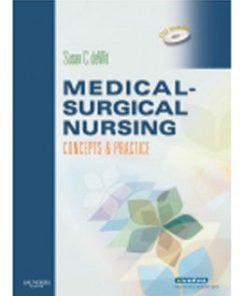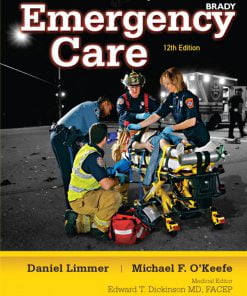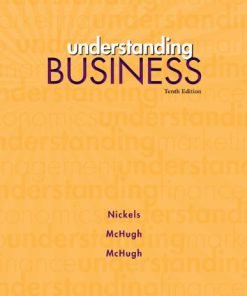Test Bank for Research Methods Concepts and Connections, 2nd Edition Michael Passer
$55.00 Original price was: $55.00.$29.99Current price is: $29.99.
Test Bank for Research Methods Concepts and Connections, 2nd Edition, Michael Passer,
Sell by: Layla Sullivan
Category: Test Bank
This is completed downloadable of Test Bank for Research Methods Concepts and Connections, 2nd Edition Michael Passer

Product Details:
- ISBN-10 : 1464106002
- ISBN-13 : 978-1464106002
- Author: Michael Passer
With over two decades of classroom experience, Michael Passer knows how to guide students through the ins and outs of research methods in ways they can actually understand and put into practice. In this remarkable text, Passer’s experience leads to chapters filled with clear explanations, resonant examples, and contemporary research from across the breadth of modern psychology, all while anticipating common questions and misunderstandings. This edition features new full-page infographics summarizing key concepts and fully updated research. It can be packaged FREE with Worth Publishers’ LaunchPad Solo for Research Methods—the ideal online component for the text, featuring videos and activities that put students in the role of either experimenter or research subject.
Table of Content:
- Chapter 1 Science and Psychology
- How Do We Know?
- The Three-Door Problem
- Tenacity: Knowing by Force of Habit
- Authority: Knowledge Gained From Others
- Reason: Relying on Logic and Rationality
- Empiricism: Knowledge Based on Experience
- Science: Relying on Systematic Empiricism
- Concept Check 1.1 How Do We Know?
- Goals of Science
- Description
- Explanation
- Prediction
- Control
- Concept Check 1.2 Goals of Science
- Characteristics of Science
- Science Involves Assumptions
- Science Is Empirical and Systematic
- Science Focuses on Testable Questions
- Science Strives for Accuracy and Objectivity
- Science Requires Clear Definitions
- Science Involves Public Reporting
- Scientific Knowledge Is Tentative, Not Absolute
- Science Is Self-Correcting
- Science Has Limitations
- Concept Check 1.3 Characteristics of Science
- Basic and Applied Research
- Concept Check 1.4 Basic and Applied Research
- Benefits of Learning About Research Methods
- Concept Check 1.5 Benefits of Learning About Research Methods
- Skepticism, Science, and Everyday Life
- What Is Skepticism?
- Evaluating Claims
- Skepticism and Anecdotal Evidence
- Concept Check 1.6 Skepticism, Science, and Everyday Life
- Chapter Summary
- Key Terms
- Assess Your Knowledge
- Concept Checks: Answers
- Thinking Critically and Applying Your Knowledge
- Chapter 2 Conducting Psychological Research
- Generating Research Ideas
- Personal Experience and Daily Events
- Prior Research and Theory
- Real-World Problems
- Serendipity
- Concept Check 2.1 Generating Research Ideas
- Gathering Background Information
- Searching Scientific Databases
- Obtaining Articles
- Reading Research Articles
- Reading Review Articles
- Concept Check 2.2 Gathering Background Information
- Forming a Hypothesis
- Forming Hypotheses Inductively and Deductively
- Characteristics of a Good Hypothesis
- Concept Check 2.3 Forming a Hypothesis
- Designing and Conducting a Study
- Approaches to Conducting Research
- Planning and Performing the Study
- The Role of Sampling
- Concept Check 2.4 Designing and Conducting a Study
- Analyzing Data and Drawing Conclusions
- Quantitative and Qualitative Analysis
- Descriptive and Inferential Statistics
- Drawing Conclusions
- Concept Check 2.5 Analyzing Data and Drawing Conclusions
- Reporting the Findings
- Concept Check 2.6 Reporting the Findings
- Building Knowledge and Theories
- Characteristics of a Good Theory
- Proof and Disproof
- Concept Check 2.7 Building Knowledge and Theories
- Chapter Summary
- Key Terms
- Assess Your Knowledge
- Concept Checks: Answers
- Thinking Critically and Applying Your Knowledge
- Chapter 3 Conducting Ethical Research
- The Importance of Research Ethics
- Concept Check 3.1 The Importance of Research Ethics
- Codes of Research Ethics
- The Nuremberg Code
- The Belmont Report and Federal Regulations
- The American Psychological Association Ethics Code
- Adhering to Ethics Codes: Ambiguities and Dilemmas
- Concept Check 3.2 Codes of Research Ethics
- Ethical Standards in Human Subjects Research
- Institutional Review
- Assessing Risks and Benefits
- Informed Consent
- Deception
- Debriefing
- Concept Check 3.3 Ethical Standards in Human Subjects Research
- Ethical Issues in Nonhuman Animal Research
- Animal Research in Psychology
- Why Study Animals?
- Ethical Perspectives and Attitudes
- Animal Research and Animal-Rights Activism
- Does Animal Research Yield Benefits?
- Humane Care and Use
- Concept Check 3.4 Ethical Issues in Nonhuman Animal Research
- Scientific Integrity
- Avoiding False or Deceptive Statements
- Reporting Research Results Ethically
- Plagiarism
- Concept Check 3.5 Scientific Integrity
- Chapter Summary
- Key Terms
- Assess Your Knowledge
- Concept Checks: Answers
- Thinking Critically and Applying Your Knowledge
- Chapter 4 Defining and Measuring Variables
- Types of Variables
- Categorical (Qualitative) and Quantitative Variables
- Discrete and Continuous Variables
- Independent and Dependent Variables
- Hypothetical Constructs
- Mediator and Moderator Variables
- Concept Check 4.1 Types of Variables
- Defining Variables
- Conceptual Definitions
- Operational Definitions
- Operational Definitions in Everyday Life
- Concept Check 4.2 Defining Variables
- Scales of Measurement
- Nominal Scales
- Ordinal Scales
- Interval Scales
- Ratio Scales
- Concept Check 4.3 Scales of Measurement
- Measurement Accuracy, Reliability, and Validity
- Accuracy of Measurement
- Reliability of Measurement
- Validity of Measurement
- Some Final Thoughts
- Concept Check 4.4 Measurement Accuracy, Reliability, and Validity
- Chapter Summary
- Key Terms
- Assess Your Knowledge
- Concept Checks: Answers
- Thinking Critically and Applying Your Knowledge
- Chapter 5 Correlation and Correlational Research
- Correlation: Basic Concepts
- Correlational Research
- Positive and Negative Correlation
- Measuring and Graphing Correlations
- Concept Check 5.1 Correlation: Basic Concepts
- Correlation Does Not Establish Causation
- The Bidirectionality Problem
- The Third-Variable Problem
- Can We Gain a Clearer Causal Picture?
- Media Reports of Correlational Research
- Concept Check 5.2 Correlation Does Not Establish Causation
- Correlation and Prediction
- Using One Predictor
- Using Two or More Predictors
- Concept Check 5.3 Correlation and Prediction
- Benefits of Correlational Research
- Prediction in Daily Life
- Test Validation
- Venturing Where Experiments Cannot Tread
- Hypothesis and Model Testing
- Convergence with Experiments
- Concept Check 5.4 Benefits of Correlational Research
- Special Issues
- Nonlinear Relations
- Range Restriction
- Associations Involving Categorical Variables
- Concept Check 5.5 Special Issues
- Chapter Summary
- Key Terms
- Assess Your Knowledge
- Concept Checks: Answers
- Thinking Critically and Applying Your Knowledge
- Chapter 6 Case Studies and Observational Research
- Case Studies
- Basic Characteristics
- Why Conduct Case Studies?
- Types of Case Studies
- Gathering and Analyzing Data
- Limitations of Case Studies
- Concept Check 6.1 Case studies
- Observational Research
- Basic Characteristics
- Why Conduct Observational Research?
- Types of Observational Research
- Recording Observations
- Sampling Behavior
- Limitations of Observational Research
- Concept Check 6.2 Observational Research
- Unobtrusive Measures and Archival Records
- Concept Check 6.3 Unobtrusive Measures and Archival Records
- Chapter Summary
- Key Terms
- Assess Your Knowledge
- Concept Checks: Answers
- Thinking Critically and Applying Your Knowledge
- Chapter 7 Survey Research
- Basic Characteristics of Surveys
- Populations and Samples
- Why Conduct Surveys?
- Limitations of Surveys
- Concept Check 7.1 Basic Characteristics of Surveys
- Selecting a Sample
- Probability Sampling
- Nonprobability Sampling
- Margin of Sampling Error and Confidence Level
- Why Not Aim for More Precise Estimates?
- Concept Check 7.2 Selecting a Sample
- Constructing the Questionnaire
- Steps in Developing a Questionnaire
- Types of Questions
- Multiple-Choice, Ranking, and Forced-Choice Questions
- Wording the Questions: it’s Harder Than You Think
- Placing the Questions in Order
- Concept Check 7.3 Constructing the Questionnaire
- Administering the Survey
- Face-to-Face Interviews
- Telephone Interviews
- Mail Surveys
- Online Surveys
- Response Rate and Nonresponse Bias
- Concept Check 7.4 Administering the Survey
- Being a Smart Survey Consumer
- Thinking Critically about Survey Results
- Being Aware of Bogus Surveys
- Concept Check 7.5 Being a Smart Survey Consumer
- Chapter Summary
- Key Terms
- Assess Your Knowledge
- Concept Checks: Answers
- Thinking Critically and Applying Your Knowledge
- Chapter 8 Single-Factor Experimental Designs
- The Logic of Experimentation
- Exercising Control Over Variables
- Causal Inference and Experimental Control
- Concept Check 8.1 The Logic of Experimentation
- Manipulating Independent Variables
- Varying the Amount or Type of a Factor
- Determining the Number of Conditions
- Experimental and Control Conditions
- Concept Check 8.2 Manipulating Independent Variables
- Between-Subjects Designs
- Advantages of Between-Subjects Designs
- Disadvantages of Between-Subjects Designs
- Types of Between-Subjects Designs
- Random Assignment Versus Random Sampling
- Concept Check 8.3 Between-Subjects Designs
- Within-Subjects Designs
- Advantages of Within-Subjects Designs
- Disadvantages of Within-Subjects Designs
- Counterbalancing and Temporal Spacing
- Types of Within-Subject Designs
- Concept Check 8.4 Within-Subjects Designs
- Examining the Results: General Concepts
- Concept Check 8.5 Examining the Results: General Concepts
- Chapter Summary
- Key Terms
- Assess Your Knowledge
- Concept Checks: Answers
- Thinking Critically and Applying your Knowledge
- Chapter 9 Factorial Designs
- Basic Characteristics of Factorial Designs
- Describing a Factorial Design
- Advantages of Factorial Designs
- Limitations of Factorial Designs
- Concept Check 9.1 Basic Characteristics Of Factorial Designs
- Understanding Main Effects and Interactions
- Possible Outcomes in a 2 × 2 Design
- Analyzing the Results: General Concepts
- Concept Check 9.2 Understanding Main Effects and Interactions
- Designing a Factorial Experiment
- Determining the Number of Conditions
- Incorporating Subject Variables
- Examining Changes in a Dependent Variable Over Time
- Concept Check 9.3 Designing a Factorial Experiment
- Experiments With More Than Two Independent Variables
- Concept Check 9.4 Experiments With More Than Two Independent Variables
- Chapter Summary
- Key Terms
- Assess your Knowledge
- Concept Checks: Answers
- Thinking Critically and Applying your Knowledge
- Chapter 10 Experimentation And Validity: A Closer Look
- Critical Thinking, Inference, and Validity
- Categories of Inference
- Inference in Tryon’s Selective Breeding Project
- Concept Check 10.1 Critical Thinking, Inference, and Validity
- Types of Validity
- Construct Validity
- Statistical Conclusion Validity
- Internal Validity
- External Validity
- Concept Check 10.2 Types of Validity
- Basic Threats to Internal Validity
- Seven Sources of Threat
- How Experiments Address These Threats
- Concept Check 10.2 Basic Threats to Internal Validity
- Other Issues Concerning Experimental Control
- Demand Characteristics
- Experimenter Expectancy Effects
- Placebo Effects and Placebo Control Groups
- Yoked Control Groups
- Ceiling and Floor Effects
- Pilot Studies, Manipulation Checks, and Debriefing
- Concept Check 10.4 Other Issues Concerning Experimental Control
- Strategies for Replicating Research
- Who Conducts the Replication?
- Complete and Partial Replication
- Direct Replication
- Conceptual Replication
- Replication and Extension
- Two Approaches to “Big Replication”
- Replication, Factorial Designs, and External Validity
- Concept Check 10.5 Strategies for Replicating Research
- Chapter Summary
- Key Terms
- Assess Your Knowledge
- Concept Checks: Answers
- Thinking Critically and Applying Your Knowledge
- Chapter 11 Quasi-Experimental Designs
- What Is a Quasi-Experiment?
- Quasi-Experiments and Experimental Control
- Advantages and Disadvantages
- Diagramming Quasi-Experimental Designs
- Concept Check 11.1 What Is a Quasi-Experiment?
- Designs Without a Control Group
- Basic Threats to Internal Validity
- One-Group Posttest-Only Design
- One-Group Pretest–Posttest Design
- Simple Interrupted Time-Series Design
- Concept Check 11.2 Designs Without a Control Group
- Designs With a Nonequivalent Control Group
- Basic Threats to Internal Validity
- Posttest-Only Design With a Nonequivalent Control Group
- Pretest–Posttest Design With a Nonequivalent Control Group
- Interrupted Time-Series Design With a Nonequivalent Control Group
- Concept Check 11.3 Designs With a Nonequivalent Control Group
- Switching Replication Designs
- Pretest–Posttest Design With Switching Replication
- Switching Replication With Treatment Removal
- Concept Check 11.4 Switching Replication Designs
- Program Evaluation
- Benefits and Constraints of Program Evaluation
- Components of Program Evaluation
- Program Diffusion
- Concept Check 11.5 Program Evaluation
- Chapter Summary
- Key Terms
- Assess Your Knowledge
- Concept Checks: Answers
- Thinking Critically and Applying Your Knowledge
- Chapter 12 Single-Case Experimental Designs
- A Single-Case Approach to Experimentation
- Key Features
- Advantages
- Use in Basic and Applied Research
- Concept Check 12.1 A Single-Case Approach to Experimentation
- Types of Single-Case Designs
- ABAB (Withdrawal/Reversal) Designs
- Multiple-Baseline Designs
- Changing-Criterion Designs
- Combined Designs
- Extending Single-Case Designs to Social Units
- Concept Check 12.2 Types of Single-Case Designs
- Issues Concerning Single-Case Designs
- Ethical Issues
- Internal Validity
- Data Analysis
- Examining Interactions
- External Validity
- Concept Check 12.3 Issues Concerning Single-Case Designs
- Chapter Summary
- Key Terms
- Assess Your Knowledge
- Concept Checks: Answers
- Thinking Critically and Applying Your Knowledge
- Statistics Modules
- Module 1 Descriptive and Inferential Statistics
- 1.1 Descriptive Statistics
- 1.2 Inferential Statistics
- Module 2 Frequency Distributions
- 2.1 Types of Frequency Distributions
- 2.2 Graphs of Frequency Distributions
- Module 3 Measures of Central Tendency
- 3.1 The Mode, Mean, and Median
- 3.2 Advantages and Disadvantages
- Module 4 Measures of Dispersion
- 4.1 The Range, Variance, and Standard Deviation
- 4.2 Calculating Measures of Dispersion
- Module 5 Correlation
- 5.1 Common Correlation Statistics
- 5.2 Calculating a Pearson Correlation Coefficient
- 5.3 Regression Analysis
- Module 6 The Normal Curve
- 6.1 Basic Concepts
- 6.2 Importance of the Normal Curve
- 6.3 Skewed Distributions
- Module 7 z Scores
- 7.1 Basic Concepts
- 7.2 Calculating a z Score
- 7.3 z Scores and the Normal Curve
- Module 8 Sampling Error
- 8.1 Sampling Variability and Sampling Error
- 8.2 Standard Error of the Mean
- Module 9 Inferential Analysis: Null Hypothesis Testing and Statistical Significance
- 9.1 The Null Hypothesis
- 9.2 Probability Values and Statistical Significance
- 9.3 Type I and Type II Error
- Module 10 The Chi-Square Test for Goodness of Fit
- 10.1 Basic Concepts
- 10.2 Performing a Chi-Square Goodness-of-Fit Test
- 10.3 Degrees of Freedom
- Module 11 The Chi-Square Test for Independence
- 11.1 Basic Concepts
- 11.2 Performing a Chi-Square Test for Independence
- Module 12 The t Test
- 12.1 Basic Concepts
- 12.2 Performing a t Test
- Module 13 Effect Size
- 13.1 Basic Concepts
- 13.2 Calculating Effect Size
- Module 14 Power and Power Analysis
- 14.1 Basic Concepts
- 14.2 Calculating Power and Sample Size
- Module 15 Confidence Intervals
- 15.1 Basic Concepts
- 15.2 Calculating Confidence Intervals
- Module 16 Analysis of Variance (Anova)
- 16.1 The Purpose of Analysis of Variance
- 16.2 Underlying Principles
- 16.3 Performing a One-Way Anova
- Key Terms
- Appendix A Communicating Research Results
- APA Style Research Articles and Review Articles
- Step 1: Planning Your Report
- Locating Appropriate Source Material
- Reading Source Material
- Constructing an Outline and Taking Notes
- Step 2: Writing a First Draft
- General Information About APA Style Formatting
- The Title Page
- The Abstract
- The Introduction
- Citations and Avoiding Plagiarism
- Method Section of a Research Article
- Results Section of a Research Article
- Discussion Section of a Research Article
- The References
- Step 3: Editing and Making Corrections
- Grammar and Punctuation Rules for Scientific Writing
- Concluding Thoughts About Writing a Manuscript
- Poster Presentations
- Poster Content
- Poster Layout
- Discussing Your Poster
- Key Terms
- Sample Annotated Student Manuscript
- Appendix B American Psychological Association Ethical Principles of Psychologists and Code of Conduct
- General Principles
- Standard 3: Human Relations
- Standard 4: Privacy and Confidentiality
- Standard 5: Advertising and Other Public Statements
- Standard 8: Research and Publication
- Appendix C Statistical Tables
- Appendix D Answers to Thinking Critically and Applying Your Knowledge Questions
- Glossary
- References
- Notes
- Name Index
- Subject Index
- Back Cover
People Also Search:
research methods concepts and connections 3rd edition pdf
research methods concepts and connections 3rd edition test bank pdf
research methods concepts
Related products
Sale!
Sell by: Matthew Clark
Sale!
Sell by: Gavin Barrett
Sale!
Sell by: Michael Johnson
Sale!
Sell by: Trevor Lawrence
Sale!
Sell by: Ethan Anderson
Sale!
Sell by: Ellie Graham
Sale!
Sell by: Alexander King
Sale!
Sell by: Anthony Campbell











